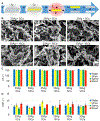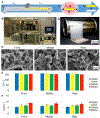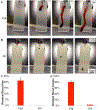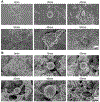Reduced Blood Coagulation on Roll-to-Roll, Shrink-Induced Superhydrophobic Plastics
- PMID: 26784916
- PMCID: PMC9431487
- DOI: 10.1002/adhm.201500697
Reduced Blood Coagulation on Roll-to-Roll, Shrink-Induced Superhydrophobic Plastics
Abstract
The unique antiwetting properties of superhydrophobic (SH) surfaces prevent the adhesion of water and bodily fluids, including blood, urine, and saliva. While typical manufacturable approaches to create SH surfaces rely on chemical and structural modifications, such approaches are expensive, require postprocessing, and are often not biocompatible. By contrast, it is demonstrated that purely structural SH features are easily formed using high throughput roll-to-roll (R2R) manufacturing by shrinking a prestressed thermoplastic with a thin, stiff layer of silver and calcium. These features are subsequently embossed into any commercially available and Food and Drug Administration (FDA)-approved plastic. The R2R SH surfaces have contact angles >150° and contact angle hysteresis <10°. Importantly, the surfaces minimize blood adhesion, leading to reduced blood coagulation without the need for anticoagulants. SH surfaces have >4200× reduction of blood residue area compared to the nonstructured controls of the same material. In addition, blood clotting is reduced >5× using whole blood directly from the patient. Furthermore, these surfaces can be easily configured into 3D shapes, as demonstrated with SH tubes. With the simple scale-up production and the eliminated need for anticoagulants to prevent clotting, the proposed conformable SH surfaces can be impactful for a wide range of medical tools, including catheters and microfluidic channels.
Keywords: anticoagulation; biomaterial; blood clotting; roll-to-roll manufacturing; superhydrophobic.
© 2016 WILEY-VCH Verlag GmbH & Co. KGaA, Weinheim.
Figures






References
-
- Ma M, Hill RM, Curr. Opin. Colloid Interface Sci 2006, 11, 193.
-
- Zhang Y-L, Xia H, Kim E, Sun H-B, Soft Matter 2012, 8, 11217.
-
- Cassie BD, Baxter S, Trans. Faraday Soc 1944, 40, 546.
-
- Lafuma A, Quéré D, Nat. Mater 2003, 2, 457. - PubMed
-
- Ma M, Hill RM, Lowery JL, Fridrikh SV, Rutledge GC, Langmuir 2005, 21, 5549. - PubMed
Publication types
MeSH terms
Substances
Grants and funding
LinkOut - more resources
Full Text Sources
Other Literature Sources

